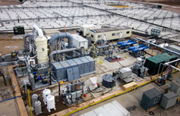Managing PFAS Risk: Soil Treatment with High Temperature Thermal Conductive Heating
Building on our two previous PFAS blog posts on the history of PFAS regulation and managing PFAS risk, and our capabilities for remediating PFAS in groundwater with ColloidalChem™ and ColloidalChem + Anchor™, this post introduces TerraTherm™, a Cascade company, and our solution for remediating PFAS-contaminated soil with High Temperature Thermal Conductive Heating (TCH) technology.
The EPA’s recently announced suite of PFAS regulations is the equivalent of a tectonic shift for U.S. manufacturers and users of PFAS, many of whom became legally responsible parties (RPs) overnight. In boardrooms and C-suites across the country, RPs are taking stock to assess and mitigate PFAS risk and reduce liability. Our aim is to help environmental consulting firms and RPs understand the range of available PFAS remediation technologies and develop effective remediation action plans to comply with the new EPA regulations.
What is High Temperature TCH?
Originally developed in the 1990s by Shell, TerraTherm’s High Temperature TCH utilizes electric or gas heaters to heat soil to temperatures >100°C. TerraTherm’s patent-pending approach for treating PFAS using High Temperature TCH targets heating soils safely and efficiently to 400°C. At this temperature, all PFAS chemicals are mineralized, including target compounds, precursors, Products of Incomplete Degradation (PIDs), and even short-chained Volatile Fluorinated Compounds (VFCs) such as C2F6 and CF4, which are highly potent and long-lived greenhouse gases. Importantly, thermal remediation removes the PFAS compounds regulated today as well as those that may be regulated in the future, eliminating the specter of long-term liability.
High Temperature TCH can be performed in situ, or ex situ in piles, with heaters installed in a grid pattern to ensure uniform heating (Figure 1). The TCH system includes heating elements, temperature monitoring devices, and insulation to provide efficient heat transfer and energy use. Steam, air and any contaminant vapors are removed from the treatment zone during heating using vapor extraction wells. High Temperature TCH is best operated only in the vadose zone to ensure uniform achievement of the elevated temperatures required for PFAS.

The timeframe for High Temperature TCH PFAS remediation depends upon the volume of soil to be treated, power or natural gas supply limitations, and the area available for treatment, but typically ranges from 6-12 months with a heating duration of 3-6 months.
Besides PFAS, TCH has been used to treat a wide range of soil contaminants, including VOCs, BTEX, SVOCs, SVOCs, PAHs, PCBs, coal tars, creosote, dioxins, TPH, and MGP waste. The treatment temperatures for different COCs are shown in Figure 2. Over the past 20 years, TerraTherm has successfully treated over 80 sites with TCH targeting 100°C and 19 sites with High Temperature TCH targeting 350 to 500°C.

PFAS Removal Mechanisms with High Temperature TCH
TerraTherm and our European partner Kruger, have studied the thermal destruction of PFAS in soils to identify the remediation mechanisms. Following heating to 400°C, the PFAS are defluorinated and mineralized to fluoride, carbon dioxide, and carbon monoxide.
Depending on soil mineralogy, the geochemistry of the water present, the nature of the PFAS, and the rate of heating, near 100% of the PFAS can be mineralized, with only very small amounts observed in the extracted vapors (i.e., ~0.01% of the PFAS fluorine).
Mineralization of the PFAS may be catalyzed by natural minerals present in the soil and groundwater such as calcium carbonates. Fluorine that is produced from the mineralization appears to be sequestered as non-mobile metal fluorides bound to the soil such as calcium fluoride and iron fluoride, resulting in very little to no production or presence of hydrofluoric acid (HF) in the extracted vapor stream.
In our laboratory studies, we have closed the fluorine mass balance to account for 100% of the fluorine associated with the starting PFAS in soil. After heating soil to 350 to 400°C, between 40% and 100% of the fluorine remains in the soil as inorganic fluorides and metal fluorides from the mineralization of the PFAS. Depending on the nature of the soil and PFAS and the treatment temperature, between 0 to 60% of the fluorine leaves the soil as a combination of HF and volatile PFAS (likely PIDs and VFCs).
TerraTherm’s patent pending thermal catalytic systems were also tested and resulted in the near complete mineralization of the volatized PFAS and fluorinated compounds present in the vapor stream extracted from the heated soil. The catalyst systems tested resulted in less than 0.01% of the fluorine from the PFAS starting in the soil emitted as target PFAS compounds. Any HF produced from the process is removed using standard acid-gas scrubbing technologies.
Cascade’s Integrated Technologies for Comprehensive PFAS Remediation
Given the sheer scope of the PFAS crisis, the environmental remediation industry must rise to the challenge and deliver the most advanced solutions for cost-effective PFAS removal and risk management. Though the EPA’s current focus is on regulating PFAS in drinking water, the ultimate source zone releases of PFAS chemicals are generally in soils, and the EPA is expected to turn its attention to source zone cleanup and plume management in the near future. Thus, a truly comprehensive risk-management approach must therefore address PFAS in both groundwater and soil.
While offsite disposal of PFAS-contaminated soil is an option, the RP must take into consideration potentially higher future costs and the probability that landfills and incineration surface impoundments, tank farms, roll off storage and ash landfills may already have PFAS contamination under the new CERCLA requirements. Also, in situ stabilization options still leave PFAS in soil, and though not mobile, future remediation may be required. On-site treatment of PFAS source zones using TerraTherm’s patent pending High Temperature TCH process limits future liability for today’s targeted PFAS compounds, and those that may be regulated in the future.
As the nation’s only vertically integrated provider of both drilling and remediation services, Cascade offers a full suite of technologies to streamline PFAS remediation in groundwater and soil source zones. In addition to TerraTherm High Temperature TCH, our wraparound technologies and services include:
- High-resolution site characterization (HRSC) with WaterlooAPS, the premier tool for collecting hydrostratigraphic data simultaneously with groundwater samples on a single direct push rig advancement. WaterlooAPS enables high-resolution design optimization (HRDO) with reliable flux measurements that identify the transmissive and storage zones and determine the optimal target intervals for installing PRBs.
- In situ groundwater PFAS plume treatment with ColloidalChem™ and ColloidalChem + Anchor™, injectable colloidal activated carbon (2-3 µm) which sequesters PFAS via adsorption, and then physically anchors these mobile amendments in PRB applications utilizing patented enzyme technology.
- Fully automated injection with Pathfinder, designed to deliver colloidal solids like ColloidalChem™ directly to transmissive zones for optimal contact with PFAS. Pathfinder delivers uniform distribution, and constant pressure and flow to distribute colloidal solids and liquids evenly without exceeding the fracture pressure or the site’s hydraulic capacity. Pathfinder systems can perform at up to 10 simultaneous locations, with direct push or injection wells.
With an integrated suite of effective PFAS remediation technologies, Cascade offers all-inclusive services from site characterization to PFAS remediation of groundwater and source zone soils. As a full-service implementation partner, we can offer economies of scale that other providers can’t provide. With Cascade, your clients can bank on getting the most cost-effective and efficient PFAS approach in the industry (Figure 3).

Cascade – Your Partner in Managing PFAS Risk
The remediation industry is facing an unprecedented opportunity with PFAS, and with that comes many challenges. As a national leader in supporting consultants by supplying groundwater and soil remediation technologies and services, Cascade is here to support your consulting and remediation needs, and help your clients manage their PFAS risk and liability. Our technical experts and experienced field crews are standing by with PFAS solutions, so contact us today.
You can also learn more about our capabilities from the webinars and resources below. If you missed the first two blog posts in this PFAS series, you can find them here: EPA PFAS Regulations: Managing Risk, Limiting Liability and Managing PFAS Risk: Plume Treatment with ColloidalChem™.












